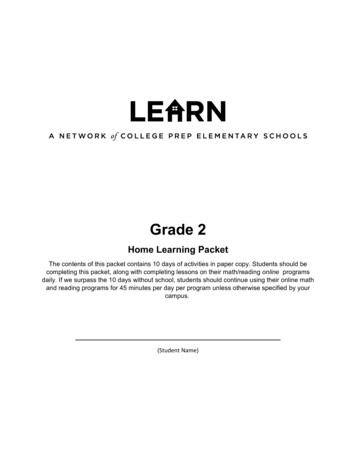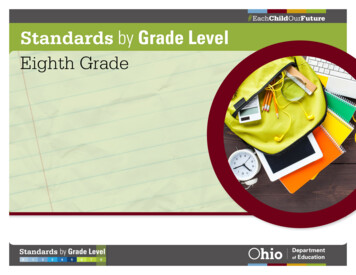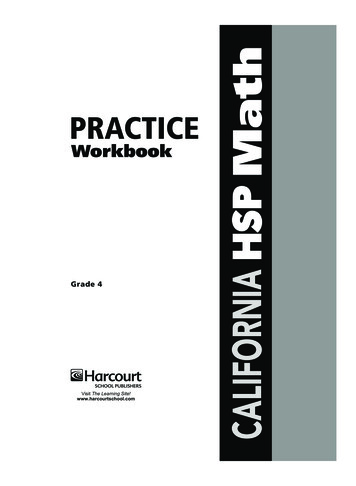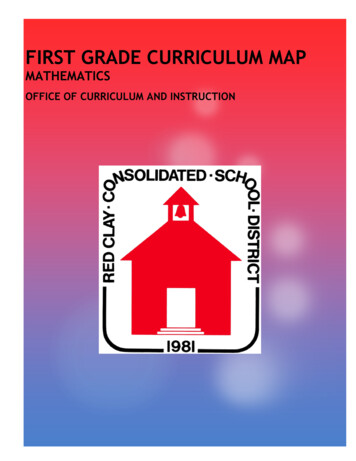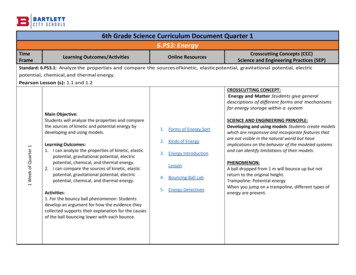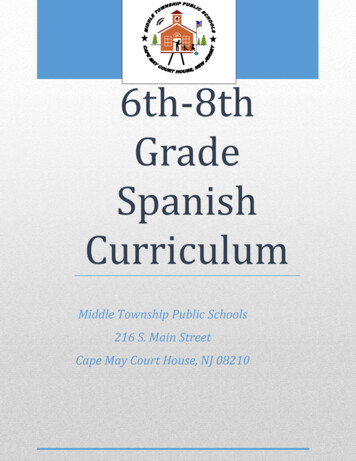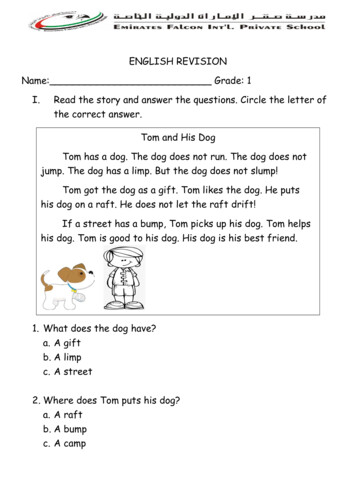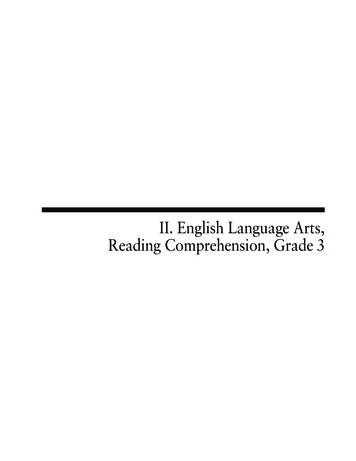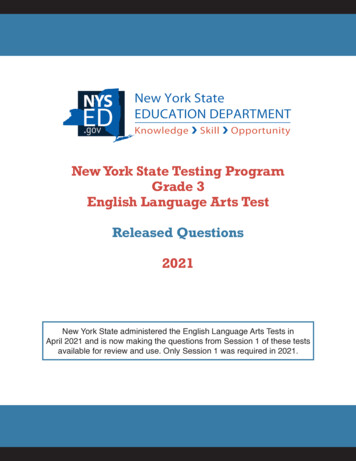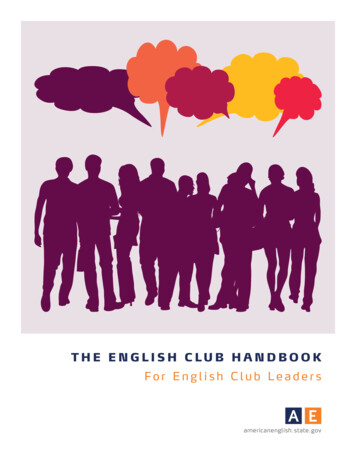
Transcription
ENGLISH CURRICULUM GUIDEGRADE 10LOUDOUN COUNTY PUBLIC SCHOOLS2012-2013
English Leadership TeamRhonda AlleySteve BarhamFreyja BergthorsonLaura BolyardMelanie BuckleyNeelum ChaudhryChris CuozzoCassandra DonahueMeghann DonohuePeggy GearhartShelli GlynnDavid HoffmanColleen MilliganJim NolandShelah NovakShannon O’NeillMarcia OwensJo Ann PearsonLaura PurvisToni RaderPhil RosenthalFatima SchererHolly SharpKaren SkeesTammy SvitekAllyson WhiteJason WhiteDr. Edgar B. HatrickSuperintendentSharon D. AckermanAssistant Superintendent, InstructionEric L. StewartDirector, Curriculum and InstructionDr. Michele Schmidt MooreSupervisor, English/Language ArtsDavid ArbogastEnglish SpecialistThis document, based on the Virginia Department of Education’s English Standards of LearningCurriculum Framework (2010), provides extensions and additions to form the Loudouny EnglishCurriculum.
LOUDOUN COUNTY PUBLIC SCHOOLSENGLISH 10 CURRICULUM GUIDECONTENTSMission Statement .2BMA Checklists . 3LCPS and Virginia SOL Requirements . 8Communication Strand 9Reading Strand 13Writing Strand . 32Research Strand . 46Vocabulary Strand . 52Sample Unit . 53AppendixInternet Safety . 63LCPS Plagiarism Policy . 65LCPS Guidelines for Video/DVD Use, Grades 9-12 . 65Ten Things Teachers Should Know about Copyright . 66How to Request Permission to Duplicate Copyrighted Materials 67Critical Perspectives . 68Standardized Test Preparation . 71Resources for Writing and Critical Reading 80
THE LCPS H IGH SCHOOL ENGLISH PRO GRAMHigh school English courses provide instruction in oral language, reading and literature, writing andgrammar, research, and vocabulary. Students engage in a variety of formal and informal speechactivities. They practice whole-class and independent reading, and teachers provide skills for readingfiction and non-fiction. Students engage in analytic, argumentative, research -based, creative, andreflective writing. They also practice timed writings to prepare them for standardized tests. They mastera range of grammar and usage skills. Research instruction emphasizes the ability to analyze, synthesize,evaluate, and document information from a variety of sources. Vocabulary instruction not only preparesstudents for PSAT, SAT, and SOL tests, it helps to develop students’ reading comprehension and theirability to express themselves orally and in writing. Teachers focus on the use of context clues tounderstand unfamiliar words; distinctions between denotation and connotation; and a study ofsynonyms, antonyms, and homophones.Grade level courses challenge students to master rigorous standards while providing students withindividualized support.Academic courses focus on the same content and skills as grade level courses but require moreindependent work.Honors courses are offered in grades 9, 10, and 11. While they focus on the same content and skills asgrade level and academic courses, honors courses are distinguished by a more rigorous study ofliterature. They move at an accelerated pace, cover a greater breadth and depth of textual study, andrequire more independent work. They also are designed to prepare students to take Advanced PlacementEnglish in their senior year. Accordingly, they emphasize the ability to synthesize information from avariety of sources as they read and write. The honors level final exam is prepared at the district level andparallels the form of an AP test.1
LCPS English Department Mission StatementHere are six beliefs that we strive to make true for a ll of our students.Students communicate and collaborate effectively in wriscourse in ever-changing, realworld situations.Therefore, we will develop active and involved listeners teach students to self-advocate and ask for clarification show students how to use the right language and dictioinformal and formalsituations develop learning activities that encourage students to communicate in authenticcontexts provide opportunities for collaborative learning in research and other projects.Students think critically.Therefore, we will provide opportunities to critically analyze language aia teach processes for critical thinking and making informed decisions show students how to refine their arguments based on new information.Students understand and respect multiple perspectives and cultures.Therefore, we will explore literature that reflects many cultures engage students in multiple perspectives and ideas.Students value and appreciate the power of language through reading and writing.Therefore, we will provide opportunities for students to choose and engage in relevant and meaningfultexts provide opportunities for students to choose the audied purpose for theirwriting.Students take on challenges and reflect on progress.Therefore, we will provide opportunities for increased rigor in assignments provide frequent opportunities for students to reflect on their growth ascommunicators.Students are well-versed in technology tools used to help them communicate.Therefore, we will integrate technology tools in our teaching and in student learning.2
10th Grade BMA Checklist: 1st SemesterThis checklist indicates the content and skills that are to be covered during the first semester. Using the checklist will ensure a continuityof instruction across the district. Although there is currently no benchmark assessment test for this grade level, this checklist denotes thesemester in which the skill may be assessed in the future. Use the space in front of each item to track when it has been taught andpracticed.READINGREQUIRED READING10th grade students in LCPS can and should read 6 -8 books per quarter. The 2010 Virginia SOL suggest that at least half ofthese be nonfiction. These may include books read independently, in reading groups, and as whole-class novels. While manybooks will be selected from the Reserved or Supplemental Reading Lists, students should also select independent readingbooks from the school library or other sources.LITERATURE(LCPS) Use literary te rms in describing and analyzing selections, especially pe rtaining to plays.10.4 Read, comprehend, and analyze literary texts of different cultures and eras.a. Identify main and supporting ideas.b. Make predictions, draw inferences, and connect prior knowledge to support reading comprehension.d. Analyze the cultural or social function of literature.g. Explain the influence of historical context on the form, style, and point of view of a literary text.h. Evaluate how an author’s specific word choices, syntax, tone, and voice shape the intended meaning of thetext,achieve specific effects, and support the author’s purpose.k. Compare and contrast how rhyme, rhythm, sound, imagery, style, form, and other literar devices convey amessageand elicit a reader’s emotions.m. Use reading strategies to monitor comprehension throughout the reading process.12.4 Read, comprehend, and analyze the development of British literature and lite rature of other cultures.a. Compare and contrast the development of British literature in its historical context.b. Recognize major literary forms and their elements.c. Recognize the characteristics of major chronological eras.d. Relate literary works and authors to major themes and issues of their eras.e. Analyze the social and cultural function of British literature.SKILLS10.5 Read, inte rpret, analyze, and evaluate nonfiction texts.a. Identify text organization and structure.b. Recognize an author’s intended audience and purpose for writing.f. Draw conclusions and make inferences on explicit and implied information using textual support as evidence.h. Use reading strategies throughout the reading process to monitor comprehension.VOCABULARY10.3 Apply knowledge of word o rig ins, de rivation, and figurative language to extend vocabulary development inauthentic texts.a. Use structural analysis of roots, affixes, synonyms, antonyms, and cognates to understand complex words.b. Use context, structure, and connotations to determine meanings of words and phrases clues.c. Discriminate between connotative and denotative meanings and interpret the connotation.d. Identify the meaning of common idioms.e. Identify literary and classical allusions and figurative language in text.f. Extend general and specialized vocabulary through speaking, reading, and writing.g. Use knowledge of the evolution, diversity, and effects of language to comprehend and elaborate the meaningof texts.(LCPS) Practice PSAT and SAT type questions.3
COMMUNICATION/MEDIA LITERACY10.1 Participate in, collaborate in, and report on sma ll-g roup learning activities.a. Assume responsibility for specific group tasks.b. Collaborate in the preparation or summary of the group activity.c. Include all group members in oral presentation.d. Choose vocabulary, language, and tone appropriate to the topic, audience, and purpose.e. Demonstrate the ability to work effectively with diverse teams to accomplish a common goal.f. Collaborate with others to exchange ideas, develop new understandings, make decisions, and solve problems.g. Access, critically evaluate, and use information accurately to solve problems.4
10th Grade BMA Checklist: 1st SemesterThis checklist indicates the content and skills that are to be covered during the first semester. Using the checklist will ensure acontinuity of instruction across the district. Although there is currently no benchmark assessment test for this grade level, thischecklist denotes the semester in which the skill mayssessed in the future. Use the space in front of each item to track when ithas been taught and practiced.WRITINGStudents should be writing daily for a variety of audiences and purposes. Each 9 week period should, however, include atleast one core unit focusing on a specific kind of writing. The four required modes are listed in capital letters below. Theyare described more fully in the Writing section of this guide. In addition, throughout the year students should be engaged inReflective Writing, also described later in this guide.REQUIRED WRITINGS*ANALYTIC WRITING (English 10: 1 per semester; Honors English 10: 2 per semester)ARGUMENTATIVE WRITING (1 per semester)RESEARCHED-BASED WRITING (English 10: 1 per year, Honors English 10: 2 per year)CREATIVE WRITING (English 10: 1 per year, Honors English 10: 1 per semester)REFLECTIVE WRITING (1 per quarter) ?TIMED WRITING (3 per semester) ?*The required numbers of required writings refer to findrafts throughout the unit.? May be done in conjunction with a required writing.? May be the first draft of another writing.afts. It is expected that students will be working toward those10.6 Develop a variety of writing to pe rsuade, inte rpret, analyze, and evaluate with an emphasis on exposition andanalysis.a Generate, gather, plan, and organize ideas for writing to address a specific audience and purpose.b. Synthesize information to support a thesis.c. Elaborate ideas clearly through word choice and vivid description.d. Write clear and varied sentences, clarifying ideas with precise and relevant evidence.e. Organize ideas into a logical sequence using transitions.f. Revise writing for clarity of content, accuracy, and depth of information.g. Use computer technology to plan, draft, revise, edit, and publish writing.10.7Self- and peer-edit writing for correct grammar, capitalization, punctuation, spelling, sentence structure, andparagraphing.c. Use a style manual, such as that of the Modern Language Association (MLA) or the American PsychologicalAssociation (APA), to apply rules for punctuation and formatting of direct quotations.d. Differentiate between in-text citations and works cited on the bibliography page.RESEARCH10.8Collect, evaluate, organize, and present information to create a research product. (Follow the6-Step process described in the LCPS Information Literacy Framework .)a. Use technology as a tool to research, organize, evaluate, synthesize, and communicate information.b. Develop the central idea or focus.c. Verify the accuracy, validity, and usefulness of information.d. Make sense of information gathered from diverse sources by identifying misconceptions, main andsupporting ideas, conflicting information, point of view or bias.e. Cite sources for both quoted and paraphrased ideas using a standard method of documentation, such as that ofthe Modern Language Association (MLA) or the American Psychological Associations (APA).f. Define the meaning and consequences of plagiarism and follow ethical and legal guidelines for gathering andusing information.Produce a multi-page documented paper using a minimum of 4 sources including at least 1book, 1 print pe riodical, and 1 Inte rnet source (see required number of research based writings, above.)5
10th Grade BMA Checklist: 2nd SemesterThis checklist indicates the content and skills that are to be covered during the second semester. Using the checklist will ensure acontinuity of instruction across the district. Although there is currently no benchmark assessment test for this grade level, this checklistdenotes the semester in which the skill may be assessee future. Use the space in front of each item to track when it has been taughtand practiced.READINGREQUIRED READING10th grade students in LCPS can and should read 6 -8 books per quarter. The 2010 Virginia SOL suggest that at least half of these benonfiction. These may include books read independentl n reading groups, and as whole-class novels. While many books will beselected from the Reserved or Supplemental Reading Lists, students should select independent reading books from the school libraryor other sources.LITERATURE(LCPS) Use literary te rms in describing and analyzing selections, especially pertaining to plays.10.4 Read, comprehend, and analyze litera ry texts of different cultures and eras.c. Explain similarities and differences of techniques and literary forms represented in the literature of different culturesand eras.e. Identify universal themes prevalent in the literature of different cultures.f. Examine a literary selection from several critical perspectives.i. Compare and contrast literature from different cultures and eras.j. Distinguish between a critique and a summary.k. Compare and contrast character development in a plot to characterization in other literary forms.m. Use reading strategies to monitor comprehension throughout the reading process.12.4 Read, comprehend, and analyze the development of British literature an lite rature of other cultures.b. Recognize major literary forms and their elements.c. Recognize the characteristics of major chronological eras.d. Relate literary works and authors to major themes and issues of their eras.f. Explain how the sound of a poem (rhyme, rhythm, onomatopoeia, repetition, alliteration, assonance, and parallelism)supports the subject, mood, and theme.SKILLS10.5 Read, inte rpret, analyze, and evaluate nonfiction texts.c. Skim manuals or informational sources to locate information.d. Compare and contrast informational text.e. Interpret and use data and information in maps, charts, graphs, timelines, tables, and diagrams.g. Analyze and synthesize information in order to solve problems, answer questions, and generate new knowledge.VOCABULARY10.3 Apply knowledge of word origins, de rivation, and figurative language to extend vocabulary development in authentictexts.a. Use structural analysis of roots, affixes, synonyms, antonyms, and cognates to understand complex words.b. Use context, structure, and connotations to determine meanings of words and phrases.c. Discriminate between connotative and denotative meanings and interpret the connotation.d. Identify the meaning of common idioms.e. Identify literary and classical allusions and figurative language in text.f. Extend general and specialized vocabulary through speaking, reading, and writing.g. Use knowledge of the evolution, diversity, and effects of language to comprehend and elaborate the meaning of texts.(LCPS) Practice PSAT and SAT type questions.COMMUNICATION/MEDIA LITERACY10.2 Analyze, produce, and examine simila rities and diffe rences between visual and verbal media messages.a. Use media, visual literacy, and technology skills to create products.b. Evaluate sources including advertisements, editorials, blogs, Web sites, and other media for relationships betweenintent, factual content, and opinion.c. Determine the author’s purpose and intended effect on the audience for media messages.d. Identify the tools and techniques used to achieve the intended focus.6
10th Grade BMA Checklist: 2nd SemesterThis checklist indicates the content and skills that are to be covered during the first semester. Using the checklist will ensure acontinuity of instruction across the district. Although there is currently no benchmark assessment test for this grade level, thischecklist denotes the semester in which the skill mayssessed in the future. Use the space in front of each item to track when ithas been taught and practiced.WRITINGStudents should be writing daily for a variety of audiences and purposes. Each 9 week period should, however, include at least onecore unit focusing on a specific kind of writing. The four required modes are listed in capital letters below. They are described morefully in the Writing section of this guide. In addition, throughout the year students should be engaged in Reflective Writing, alsodescribed later in this guide.REQUIRED WRITINGS*ANALYTIC WRITING (English 10: 1 per semester; Honors English 10: 2 per semester)ARGUMENTATIVE WRITING (1 per semester)RESEARCHED-BASED WRITING (English 10: 1 per year, Honors English 10: 2 per year)CREATIVE WRITING (English 10: 1 per year, Honors English 10: 1 per semester)REFLECTIVE WRITING (1 per quarter) ?TIMED WRITING (3 per semester) ?*The required numbers of required writings refer to finthroughout the unit.? May be done in conjunction with a required writing.? May be the first draft of another writing.afts. It is expected that students will be working toward those draftsContinue implementing SOL 10.6 from 1 st semester10.7Self- and peer-edit writing for correct grammar, capitalization, punctuation, spelling, sentence structure, andparagraphing.a. Distinguish between active and passive voice.b. Apply rules governing use of the colon.c. Use a style manual, such as that of the Modern Language Association (MLA) or the American PsychologicalAssociation (APA), to apply rules for punctuation and formatting of direct quotations.d. Differentiate between in-text citations and works cited on the bibliography page.e. Analyze the writing of others.f. Describe how the author accomplishes the intended purpose of a piece of writing.g. Suggest how writing might be improved.h. Proofread and edit final product for intended audience and purpose.RESEARCH10.8Collect, evaluate, organize, and present information to create a research product.(Follow the 6-Step process described in the LCPS Information Literacy Framework )a. Use technology as a tool to research, organize, evaluate, synthesize, and communicate information.b. Develop the central idea or focus.c. Verify the accuracy, validity, and usefulness of information.d. Make sense of information gathered from diverse sources by identifying misconceptions, main andsupporting ideas, conflicting information, point of view or bias.e. Cite sources for both quoted and paraphrased ideas using a standard method of documentation, such as that ofthe Modern Language Association (MLA) or the American Psychological Associations (APA).f. Define the meaning and consequences of plagiarism and follow ethical and legal guidelines for gathering andusing information.Address issues of Internet safety.Produce a multi-page documented paper using a minimum of 4 sources including at least 1book, 1 print pe riodical, and 1 Inte rnet source (see required number of research based writings, above).7
LCPS REQUIREMENTS FOR GRADE 10The English curriculum in Loudoun County is an integrated program that involves a multi-faceted approach to learning aligned withthe Virginia SOL. The curriculum at this level focuses on actively reading a variety of literature and identifying and understandingliterary terminology. Students incorporate technology in writing and research.StrandGoalsCommunicationEmphasize small group presentations, both formal and informal; evaluate strengths and weaknesses of presentations;analyze, produce, and examine visual and verbal media messages.Survey British literature and literature from other cultures; read a variety of genres; analyze the development of literature,considering cultural archetypes, critical perspectives and cultural themes; continue to develop critical reading skills with anemphasis on reading for understanding, analysis, and evaluation; engage in daily independent reading; use critical essays toexamine perspectives in literature; begin to develop an understanding of how context and style contribute to the meaning ofa text; incorporate literary terminology in responses to texts; interpret, analyze, and evaluate nonfiction texts.Practice timed responses to a variety of prompts; practice revising and editing; develop single and multi-paragraph essaysemphasizing analytic and expository writing; write clear and varied sentences.Focus on the research process with an emphasis on organizing information from traditional and on-line sources; evaluatethe accuracy and validity of information; synthesize information for inclusion in a product (written, oral, audio-visual, etc.);write a 3-5 page research paper; include parenthetical citations; develop a works cited page.Develop vocabulary through reading and writing, with an emphasis on understanding and using new vocabulary; useknowledge of word origins to understand new vocabulary; practice PSAT and SAT-type questions.Reading AnalysisWritingResearchVocabularyVA SOL REQUIREMENT FOR GRADE 10 Knowledge of literary terms and forms will be appliedt’s own writing and in the analysis of literature. Thestudent will be introduced to significant literary works.Beginning in 2010, an increased emphasis is placed on reading and understanding nonfiction texts.Increased requirements for research and reporting in a l subjects will be supported by the use of print, electronic databases,online resources, and a standard style sheet method to cite reference sources. The student will distinguish between reliable andquestionable Internet sources.Writing will encompass narrative, literary, expository, and informational forms, with particular attention to analysis. Thestudent will demonstrate correct use of language, spel ing, and mechanics by applying grammatical conventions in writing andspeaking.8
LCPS COMMUNICATION STRANDLEVELAllGOALS: The student will work with other students cooperatively; use speaking skills to express thought and to deliverght; evaluate one’s own and others’ speaking skills; develop presentation skills: appropriate dress, inflection, tone, pace, eye contact, awareness of audience; analyze and evaluate visual and verbal media messages.9
FOCUSSTRAND: COMMUNICATION: SPEAKING, LISTENING, MEDIA LITERACYGRADE LEVEL 10At the tenth-grade level, students will become skilled communicators in small-group learning activities. Students will participate in, collaborate in,and report on small-group learning activities. They will also examine and critique the overall effectiveness of the group process. They will usegrammatically correct language that is appropriate to the topic, audience, and purpose. In addition, students will analyze, produce, and examinesimilarities and differences between visual and verbal media messages.10
STANDARD 10.110.1STRAND: COMMUNICATION: SPEAKING, LISTENING, MEDIA LITERACYThe student will participate in, collaborate in, and report on small-group learning activities.a) Assume responsibility for specific group tasks.b) Collaborate in the preparation or summary of the group activity.c) Include all group members in oral presentation.d) Choose vocabulary, language, and tone appropriate to the topic, audience, and purpose.e) Demonstrate the ability to work effectively with diverse teams to accomplish a common goal.f) Collaborate with others to exchange ideas, develop new understandings, make decisions, and solve problems.g) Access, critically evaluate, and use information accurately to solve problems.h) Evaluate one’s own role in preparation and delivery of oral reports.i) Use a variety of strategies to listen actively.j) Analyze and interpret other’s presentations.k) Evaluate effectiveness of group process in preparation and delivery of oral reports.ESSENTIALUNDERSTANDINGSUNDERSTANDING THE STANDARD(Teacher Notes) GRADE LEVEL 10Individual students will actively contribute togroup activities and participate in small-grouporal presentations.Students will evaluate their strengths andweaknesses when participating in small-grouporal presentations.Students will examine their preparation,interaction, and performances as groupmembers. In addition, students will evaluatethe overall effectiveness of their group’spreparation and presentation.ESSENTIAL KNOWLEDGE, SKILLS, AND PROCESSESAll students shouldTo be successful with this standard, students are expected to understand that small groupcollaboration exists beyondthe classroom and theirability to effectivelyparticipate is an essentialskill. assume shared responsibility for collaborative work.collaborate with peers to set rules for group presentations and discussions,set clear goals and deadlines, and define individual roles as needed.respond thoughtfully by summarizing points of agreement anddisagreement, qualifying views and understanding.demonstrate active listening through use of appropriate facial expressions,posture, and gestures.engage others in a conversation by posing and responding to questions in agroup situation.exercise flexibility and willingness in making compromises to accomplisha common goal.use grammatically correct language.11
STANDARD 10.210.2STRAND: COMMUNICATION: SPEAKING, LISTENING, MEDIA LITERACYThe student will analyze, produce, and examine similarities and differences between visual and verbal media messages.a) Use media, visual literacy, and technology skills to create products.b) Evaluate sources including advertisements, editorials, blogs, Web sites, and other media for relationships between intent,factual content, and opinion.c) Determine the author’s purpose and intended effect onaudience for media messages.d) Identify the tools and techniques used to achieve the intended focus.ESSENTIALUNDERSTANDINGSUNDERSTANDING THE STANDARD(Teacher Notes) GRADE LEVEL 10Students will continue to develop medialiteracy by comparing and contrasting visualand verbal media messages.Students will continue to create products thatreflect their expanding knowledge of mediaand visual literacy.All students should recognize that mediamessages express a viewpointand contain values.understand that there is arelationship between theauthor’s intent, the factualcontent, and opinionexpressed in media messages.ESSENTIAL KNOWLEDGE, SKILLS, AND PROCESSESTo be successful with this standard, students are expected to identify and analyze the sources and viewpoint of publications.analyze, compare, and contrast visual and verbal media messages forcontent (word choice and choice of information), intent (persuasivetechniques), impact (public opinion trends), and effectiveness (effect onthe audience).determine author’s purpose, factual content, opinion, and/or possible biasas presented in media messages.understand the purposeful useof persuasive language andword connotations conveyviewpoint and bias.12
FOCUSSTRAND: READINGGRADE LEVEL 10At the tenth-grade level, students will apply knowledge of word origins, derivations, and figurative language to extend vocabulary development inauthentic texts. They will read, comprehend, critique, and analyze a variety of literary works from various cultures and eras. They will interpretnonfiction materials. Students will learn to apply critical reading skills across the content areas, including history and social science, science, andmathematics. When selecting texts, teachers will consider appropriateness of subject and theme as well as text complexity.13
STANDARD 10.310.3STRAND: READINGThe student will apply knowledge of word origins, derivations, and figurative language to extend vocabulary development inauthentic texts.a) Use structural analysis of roots, affixes, synonyms, antonyms, and cognates to understand complex words.b) Use context, structure, and connotations to determine meanings of words and phrases.c) Discriminate between connotative and denotative meanings and interpret the connotation.d) Identify the meaning of common idioms.e) Identify literary and classical allusions and figurative language in text.f) Extend general and specialized vocabulary through speaking, reading, and writing.g) Use knowledge of the evolution, diversity, and effects of language to comprehend andelaborate the meaning of texts.ESSENTIALUNDERSTANDINGSUNDERSTANDING THE STANDARD(Teacher Notes) GRADE LEVEL 10ESSENTIAL KNOWLEDGE, SKILLS, AND PROCESSESThe intent of this standard is that students willincrease their independence as learners ofvocabulary.All students shouldTo be successful with this standard, students are expected to use roots or affixes to determine or clarify the meaning of words.Students will use prefixes, suffixes, roots,derivations, and in
10th Grade BMA Checklist: 1st Semester WRITING ANALYTIC WRITING ARGUMENTATIVE WRITING RESEARCHED-BASED WR IT NG CREATIVE WRITING REFLECTIVE WRITING TIMED WRITING 10.6 D ev l op ar ityf w ng su d,z hm x analysis. 10.7 Self -and p er edit writing for correct grammar, capitalization, punctu

